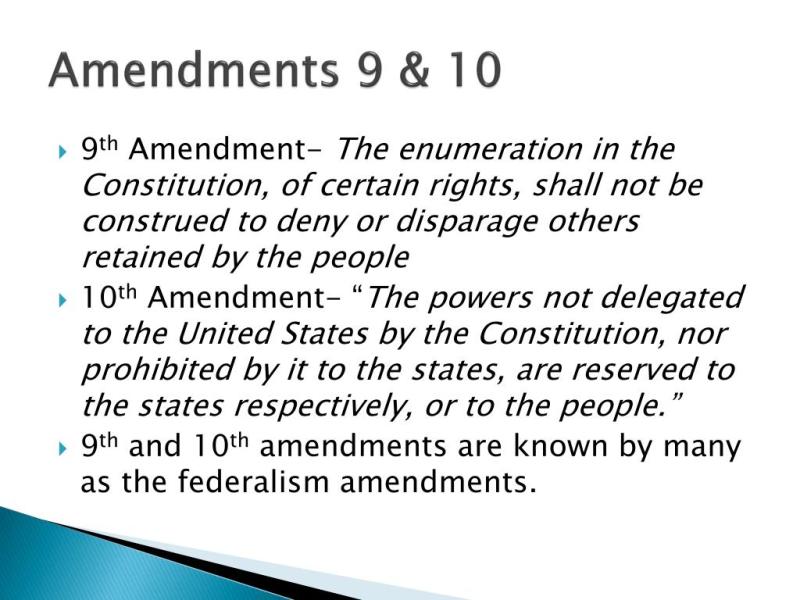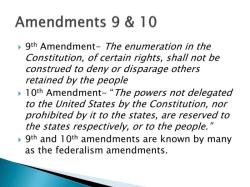What are some examples of the Ninth Amendment?
The Ninth Amendment to the U.S. Constitution states:
“The enumeration in the Constitution, of certain rights, shall not be construed to deny or disparage others retained by the people.”
This means that just because a right isn’t specifically listed in the Constitution doesn’t mean people don’t have it.
Examples of Rights Protected Under the Ninth Amendment
While the Ninth Amendment doesn’t list specific rights, courts and scholars interpret it as a protection of unenumerated rights—rights not explicitly mentioned in the Constitution.
Here are some examples often linked to the Ninth Amendment:
1. Right to Privacy
Case Example: Griswold v. Connecticut (1965)
The Supreme Court struck down a law banning contraceptives, ruling that a "right to marital privacy" existed—even though not explicitly mentioned in the Constitution.
2. Right to Make Personal Medical Decisions
Some argue that decisions about your own body, like whether to get a certain medical treatment or refuse one, fall under rights protected by the Ninth Amendment.
3. Parental Rights
Parents generally have the right to raise and educate their children as they see fit (including decisions about schooling and religion).
This right isn’t spelled out in the Constitution but is often supported by the Ninth Amendment and the Fourteenth.
4. Right to Travel Freely
The right to move between states or within the country is not listed in the Constitution, but courts have recognized it as a fundamental right potentially supported by the Ninth Amendment.
5. Right to Marry Whom You Choose
The right to marry (including interracial or same-sex marriage) has been upheld by the courts, even though it’s not explicitly listed in the Constitution.
6. Right to Autonomy in Personal Relationships
This includes decisions about intimate associations and living arrangements, such as cohabiting with others or forming family-like units.
Summary
The Ninth Amendment acts as a safety net to protect individual freedoms that the Founders believed were so fundamental that they didn’t need to be spelled out. It reminds us that people retain many rights beyond those in the Constitution.
What Is the Ninth Amendment About?
The Ninth Amendment is a part of the Bill of Rights that addresses rights not specifically listed in the Constitution.
What Are Examples of Rights Protected by the Ninth Amendment?
While the Ninth Amendment doesn't list specific rights, it has been used by courts to support various rights that aren't explicitly in the Bill of Rights.
The right to privacy: This is one of the most significant applications of the Ninth Amendment. It has been interpreted to protect a person's right to privacy in decisions about marriage, procreation, contraception, and child-rearing.
The right to travel: The freedom to move between states without government interference has been recognized as a fundamental right.
The right to an education: While not explicitly guaranteed, the Ninth Amendment has been cited in arguments for the right to access education.
The right to bodily integrity: This refers to the right to have control over one's own body and make decisions about personal health.
It's important to note that the Ninth Amendment doesn't create these rights on its own; rather, it protects them from being denied by the government.
How Has the Ninth Amendment Been Interpreted by Courts?
Courts have had a complex and evolving relationship with the Ninth Amendment. Its interpretation has been a subject of ongoing debate.
Early Interpretation: For a long time, the Ninth Amendment was largely ignored by the Supreme Court.
Many judges viewed it as simply a rule of construction, meant to clarify the relationship between the federal government and the people, rather than as a source of substantive rights. Modern Interpretation: The landmark case of Griswold v. Connecticut (1965) marked a turning point.
The Supreme Court, in this case, used the Ninth Amendment, in conjunction with other amendments (like the First, Third, Fourth, and Fifth), to establish a constitutional right to privacy in matters of contraception. The Court's decision essentially argued that the right to privacy was a fundamental, unenumerated right that the government could not infringe upon. Controversy: The interpretation of the Ninth Amendment remains controversial.
Some originalists argue that it doesn't create new rights but simply protects those already recognized at the time of the Bill of Rights' ratification. Others, particularly liberal legal scholars, view it as a living document that can be used to protect new rights as society evolves.
Why Is the Ninth Amendment Important for Unenumerated Rights?
The Ninth Amendment is crucial because it acts as a constitutional backstop for rights that were not explicitly listed by the Founders.
Protects against government overreach: It prevents the government from claiming that it can restrict any activity that isn't expressly protected by the Constitution.
It assumes that a vast number of rights exist and belong to the people, and the government cannot infringe on them without due process. Ensures a more comprehensive view of liberty: The amendment acknowledges that the list of rights in the Bill of Rights is not exhaustive.
The Founders understood that they could not foresee all future rights and liberties. The Ninth Amendment serves as a kind of catch-all provision, ensuring that the concept of liberty is not limited to a narrow list of explicit protections. Foundation for evolving rights: It provides a legal basis for courts to recognize and protect rights that have become fundamental over time, even if they weren't explicitly mentioned in the 18th century.
Can the Ninth Amendment Affect Modern Legal Issues?
Yes, the Ninth Amendment continues to be relevant in modern legal issues, though it is often used in combination with other amendments.
Privacy and Technology: In an age of digital surveillance and data collection, the Ninth Amendment is cited in arguments for the right to informational privacy and protection from government intrusion into personal data.
Bodily Autonomy: It is sometimes invoked in legal debates concerning a person's right to make decisions about their own body, including medical treatments, and issues related to reproductive rights.
New Rights: As new technologies and social norms emerge, the Ninth Amendment provides a framework for legal scholars and courts to consider whether new, unenumerated rights should be protected. While its direct application is often limited, it remains a powerful tool for arguing for the preservation of a broad range of individual liberties.


